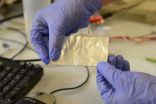(Press-News.org) Only a few U.S. nursing home residents who undergo lower extremity revascularization procedures are alive and ambulatory a year after surgery, according to UCSF researchers, and most patients still alive gained little, if any, function.
The study appears in the April 6 issue of JAMA Internal Medicine.
"Our findings can inform conversations among physicians, patients and families about the risks and expected outcomes of surgery and whether the surgery is likely to allow patients to achieve their treatment goals," said senior author Emily Finlayson, MD, MS, associate professor of surgery and geriatrics in the Philip R. Lee Institute for Health Policy Studies at UCSF. "Our findings also highlight the importance of carefully considering a prognosis independent of vascular disease and assessing the goals of care."
Lower extremity peripheral arterial disease is common among nursing home residents, a substantial number of whom also are at risk for critical limb ischemia. Lower extremity revascularization through stents and other devices is frequently performed to preserve functional independence through limb preservation. However, these procedures have an operative risk, and their benefit in maintaining walking ability is debatable.
In this study, researchers led by Finlayson analyzed Medicare claims data for 2005-2008 for nursing home residents nationwide who underwent lower extremity revascularization, with follow up through 2009. Changes were examined in the residents' ambulatory and functional status after surgery. Also identified were patient and surgery characteristics associated with a composite measure of clinical and functional failure, defined as death or nonambulatory status a year after surgery.
The key findings are:
A total of 10,784 long-term nursing home residents received lower extremity revascularization. The average age was 82 years, and 60 percent had cognitive impairment, 57 percent had congestive heart failure, and 29 percent had renal failure.
Prior to surgery, of the 10,784 residents, 75 percent were not walking, and 40 percent had decline in overall physical functioning.
A year after surgery, 51 percent of these patients had died, and among survivors, 28 percent were nonambulatory and 32 percent had decline in overall physical functioning.
Of the 1,672 residents who were ambulatory before surgery, 63 percent died or now were nonambulatory at one year.
And among 7,188 patients who were nonambulatory prior to surgery, 89 percent died or remained nonambulatory.
As a result, the researchers learned that in patients undergoing lower extremity revascularization, the outcomes in nursing home residents were substantially worse than has been reported in the general population of the same age. These findings are consistent with previous studies that found individuals who are ambulatory prior to this procedure have better outcomes than those who are nonambulatory, and revascularization rarely allows a patient who is nonambulatory to become ambulatory after surgery.
"Among the treatment options, nonoperative symptom management, local wound care, primary amputation and lower extremity revascularization are associated with different risks, benefits and expected outcomes," Finlayson said. "Our findings should be interpreted cautiously; successful relief of pain, healing of wounds and avoidance of major amputation may benefit some of the patients who underwent lower extremity revascularization in the short term."
INFORMATION:
Other UCSF contributors to the JAMA Internal Medicine study were Michael S. Conte, MD, professor and chief of vascular and endovascular surgery and co-director of the Heart and Vascular Center and Center for Limb Preservation; Kenneth Covinsky, MD, MPH, Edmund G. Brown Distinguished Professorship in Geriatrics at UCSF and San Francisco VA Medical Center geriatrics and palliative medicine service staff physician; Lawrence Oresanya, MD, resident physician of surgery; and Shoujun Zhao, MD, PhD, surgery research specialist. Other contributors were Siqi Gan, MPH, UCLA Fielding School of Public Health; Brant Fries, PhD, Institute of Gerontology and University of Michigan and VA Ann Arbor Healthcare Systems; and Philip Goodney, MD, MS, Dartmouth Geisel School of Medicine, Dartmouth Institute for Health Policy and Clinical Practice, and the VA Outcomes Group.
Funding was provided by the National Institute on Aging/Paul B. Beeson Clinical Scientist Development Award in Aging and the UCSF Claude D. Pepper Older Americans Independence Center.
UCSF is the nation's leading university exclusively focused on health. Now celebrating the 150th anniversary of its founding as a medical college, UCSF is dedicated to transforming health worldwide through advanced biomedical research, graduate-level education in the life sciences and health professions, and excellence in patient care. It includes top-ranked graduate schools of dentistry, medicine, nursing and pharmacy; a graduate division with world-renowned programs in the biological sciences, a preeminent biomedical research enterprise and top-tier hospitals, UCSF Medical Center and UCSF Benioff Children's Hospitals. Please visit http://www.ucsf.edu.
Seventy per cent of glacier ice in British Columbia and Alberta could disappear by the end of the 21st century, creating major problems for local ecosystems, power supplies, and water quality, according to a new study by University of British Columbia researchers.
The study found that while warming temperatures are threatening glaciers in Western Canada, not all glaciers are retreating at the same rate. The Rocky Mountains, in the drier interior, could lose up to 90 per cent of its glaciers. The wetter coastal mountains in northwestern B.C. are only expected to lose about ...
DURHAM, N.C. -- Duke researchers have developed a new method to precisely control when genes are turned on and active.
The new technology allows researchers to turn on specific gene promoters and enhancers -- pieces of the genome that control gene activity -- by chemically manipulating proteins that package DNA. This web of biomolecules that supports and controls gene activity is known as the epigenome.
The researchers say having the ability to steer the epigenome will help them explore the roles that particular promoters and enhancers play in cell fate or the risk ...
Stanford University scientists have invented the first high-performance aluminum battery that's fast-charging, long-lasting and inexpensive. Researchers say the new technology offers a safe alternative to many commercial batteries in wide use today.
"We have developed a rechargeable aluminum battery that may replace existing storage devices, such as alkaline batteries, which are bad for the environment, and lithium-ion batteries, which occasionally burst into flames," said Hongjie Dai, a professor of chemistry at Stanford. "Our new battery won't catch fire, even if you ...
Most of today's anticancer drugs target the DNA or proteins in tumor cells, but a new discovery by University of California, Berkeley, scientists unveils a whole new set of potential targets: the RNA intermediaries between DNA and proteins.
This RNA, called messenger RNA, is a blueprint for making proteins. Messenger RNA is created in the nucleus and shuttled out into the cell cytoplasm to hook up with protein-making machinery, the ribosome. Most scientists have assumed that these mRNA molecules are, aside from their unique sequences, generic, with few distinguishing ...
PROVIDENCE, R.I. - After analyzing stroke treatment records, researchers at Rhode Island Hospital in collaboration with researchers from the University of Cincinnati learned that women and men have different reasons for being excluded from receiving the common clot-dissolving drug, recombinant tissue plasminogen activator (rtPA). Importantly, more women had very high blood pressures, which reduced their eligibility to be treated with the highly effective drug. The study was recently published in the American Heart Association's (AHA) journal, Stroke.
"Although men and ...
Women who believe smoking helps them manage their weight are less likely to try quitting in response to anti-smoking policies than other female smokers in the U.S.
The study, published online in the journal Tobacco Control, is the first to find that smokers who are concerned about their weight are less swayed by anti-smoking policies - such as bumps in cigarette prices, smoke-free laws or anti-tobacco messaging -- than other smokers are.
"We found that concerns about weight are a significant barrier to quitting," says lead author Ce Shang of the University of Illinois ...
NEW YORK--A sad TV drama comes to conclusion, fading to black as music swells, and leaving the audience emotionally torn about the future of the main characters. Suddenly, the TV cuts to a peppy commercial and viewers are faced with the relentless cheer of an insurance spokesperson pitching their latest money saving product. This is a common occurrence in today's prime time-driven entertainment culture, but new research from Columbia Business School shows that this juxtaposition of emotions can leave TV viewers puzzled at the swing in content and emotion, so much so that ...
AURORA, Colo. (April 6, 2015) - Brain activity affects the way the developing brain connects neurons and a study by researchers at the School of Medicine on the University of Colorado Anschutz Medical Campus and Children's Hospital Colorado suggests a new model for understanding that process.
In a study of zebrafish, scientists tested how brain activity affected the development of insulating sheaths on selected axons, which are slender nerve fibers that conduct electrical impulses between neurons. They found that, while the wrapping of axons was indiscriminate, the molecular ...
Political parties find that their fortunes improve when they put more women on the ballot, according to a study co-authored by an MIT economist.
The study analyzes changes to municipal election laws in Spain, which a decade ago began requiring political parties to have women fill at least 40 percent of the slots on their electoral lists. With other factors being equal, the research found, parties that increased their share of female candidates by 10 percentage points more than their opponents enjoyed a 4.2 percentage-point gain at the ballot box, or an outright switch ...
Philadelphia ? Today in JAMA Pediatrics, researchers from The Children's Hospital of Philadelphia's (CHOP) PolicyLab published the largest study to date documenting the significant risks to children's health associated with prescription antipsychotics, a powerful a class of medications used to treat mental and behavioral health disorders. The results suggest that initiating antipsychotics may elevate a child's risk not only for significant weight gain, but also for Type II diabetes by nearly 50 percent; moreover, among children who are also receiving antidepressants, the ...

